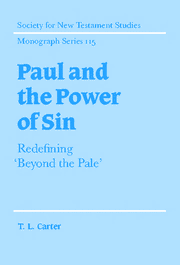Book contents
- Frontmatter
- Contents
- List of figures
- Preface
- List of abbreviations
- 1 Introduction
- 2 ‘Grid and group’
- 3 Physical and social boundaries in Corinth
- 4 Exclusive boundaries in Galatia
- 5 Small bounded groups in Rome
- 6 Inclusive boundaries in Rome
- 7 Conclusion
- Bibliography
- Index of selected subjects
- Index to ancient references
4 - Exclusive boundaries in Galatia
Published online by Cambridge University Press: 22 September 2009
- Frontmatter
- Contents
- List of figures
- Preface
- List of abbreviations
- 1 Introduction
- 2 ‘Grid and group’
- 3 Physical and social boundaries in Corinth
- 4 Exclusive boundaries in Galatia
- 5 Small bounded groups in Rome
- 6 Inclusive boundaries in Rome
- 7 Conclusion
- Bibliography
- Index of selected subjects
- Index to ancient references
Summary
Introduction
Paul's letter to the Galatians contains one clear reference to sin as a power, where Paul says that scripture has confined all things under sin (3:22). The noun ἁμαϱτία also occurs in 1:4, but this time in the plural, where Paul refers to Christ giving himself for our sins, in order to rescue us from the present evil age. It also occurs in 2:17, where Paul addresses the question whether Christ is the servant of sin. In addition, the concept of sin is found elsewhere in the letter, even though Paul does not use the term ἁμαϱτία: in Galatians 5:16–21; 6:8, he describes sinful behaviour in terms of ‘works of the flesh’; in 2:15–21, he refers to ‘Gentile sinners’ and defends himself against the accusation that those who seek to be justified in Christ are found to be sinners in the process. Paul denies the charge, stating that if he is again building the things that he destroyed, he demonstrates that he is a transgressor.
Clearly these references to sin must be understood in the context of the letter as a whole. Paul wrote to the Galatians to counter what he regards as a false gospel (1:6–9), proclaimed by outsiders, who were attempting to persuade his Galatian converts to accept circumcision (5:2–3; 6:12–13). The emphasis on circumcision points decisively towards a Jewish identity for the agitators, while the fact that they proclaim a different gospel (1:6–9) indicates that they were also Christians.
- Type
- Chapter
- Information
- Paul and the Power of SinRedefining 'Beyond the Pale', pp. 78 - 123Publisher: Cambridge University PressPrint publication year: 2001



